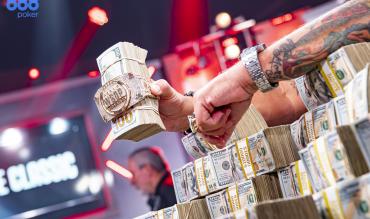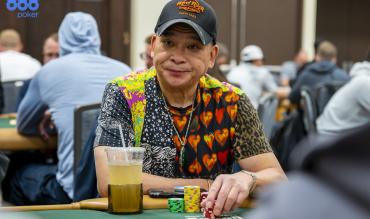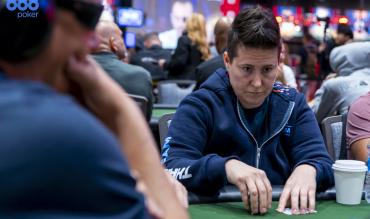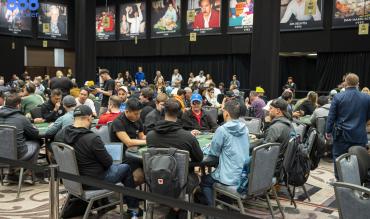The World Series of Poker (WSOP) is a series of poker tournaments held annually in Las Vegas since 1970. It all began when Benny Binion invited seven of the best and most famous poker players of that time to participate in a poker tournament.
The tournament had a designated start and end time, and the process to determine the final winner was rather unorthodox. The seven players secretly voted for one of their opponents. The player who received the most votes would become the winner.
Johnny Moss got the most votes and became the first-ever WSOP champion.
The following year, Binion introduced a freezeout format with a $10,000 buy-in, giving birth to the current WSOP format.
In 2023, the series is still going strong in the US. It has also moved across oceans to Europe and Asia.
Read on as we tell you everything there is to know about the biggest poker event in the world.
Who Was Benny Binion?
Lester Ben Binion, or Benny Binion as he later became known in the world of gambling, was born on November 20, 1904, in Pilot Grove, Texas.
Due to health issues, Binion never attended school. Instead, he accompanied his father, a horse trader, on all his travels from a young age. During these trips, the young Binion learned to play many games of chance, a common pastime among horse traders and farmers.
At 18, he moved to El Paso, where he climbed the ranks in the gambling world. Over the years, he established a private network of dice games. They operated in various hotels under the protection of a local politician.
In 1946, when Dallas County elected a new sheriff, Binion lost the protection he enjoyed and fled to Las Vegas.
After a few failed business ventures, the tycoon purchased the Eldorado Club and Apache Hotel. He opened Binion's Horseshoe in their place, which immediately became popular due to its high betting limits.
Binion was at the forefront of casino innovation in Las Vegas. Binion introduced things that are common nowadays in various casinos:
- Limousines to transport players
- Complimentary drinks for everyone
- Carpeted floors
Binion passed away in 1989 due to a heart condition, not viewing himself as highly skilled in poker,
But in 1990, he was posthumously inducted into the Poker Hall of Fame in recognition of his significant contributions to the game.
World Series Of Poker Format
Thousands of poker players from all corners of the world travel to Las Vegas in the summer of each year. They journey to compete in what is still considered the most prestigious poker tournament on the planet.
Every poker player dreams of winning one of the various WSOP events and claiming the coveted gold bracelet.
The winner of each event receives a monetary prize based on the number of entries, just like any other tournament. But it's the gold bracelet that many aspire to hold.
The bracelet was introduced as the prize for events in 1976.

The series starts somewhere between late May and early June. The WSOP consists of multiple poker tournaments held over several weeks. The Main Event, with its $19,000 buy-in, marks the culmination of the series.
The game is, of course, No-Limit Texas Hold'em, and the tournament plays out over several days. Once we reach the final nine players, the tournament pauses. The final table typically continues in November, receiving extensive media coverage.
Here, the ultimate winner receives the earned the title of Poker World Champion.
Note: In 2023, there will be no long pause – one day off between the final table bubble and the actual final table.
Since 1971, all WSOP events have offered cash prizes. It started with No-Limit Texas Hold'em. Currently, there are tournaments featuring nearly every poker variant:
- Omaha
- 2-7 Triple Draw
- H.O.R.S.E.
- Seven-Card Stud
- Razz
- Omaha Hi-Lo etc.
In 2023, there were 95 events, marking it the highest number of events in any WSOP ever.
And it wasn’t the only record set in the 2023 edition.
The 2023 World Series of Poker Main Event has set an attendance record with 10,043 entrants, beating the 8,773 entrants from 2006.

The Influence of the WSOP on the Current Poker Landscape
We have all heard of the term "Poker Boom". It refers to the moment when poker became popular with millions of people worldwide within a few years.
But what sparked the Poker Boom?
The release of the movie Rounders in 1998, starring Matt Damon and John Malkovich, planted the seeds for this boom. The film tells the story of a former poker player who returns to the tables to help a friend pay off his gambling debts.
It was also in that year that the first online poker room emerged, and its popularity grew in the following years.
However, it was in 2003 that a significant event took place!
At the time, Chris Moneymaker was an amateur poker player. Like many others, he played online in his spare time. Moneymaker secured his $10,000 buy-in 2003 WSOP Main Event entry via an $86 satellite tournament.
Nevertheless, Chris never imagined what would happen. A total of 839 players fought for the bracelet that year.
And in the end, Moneymaker triumphed over them all, becoming the World Champion.
An amateur player managed to win the most prestigious tournament in the world and secure a prize of $2.5 million. It had only cost him $86 to enter, and the repercussions were felt everywhere.
In the blink of an eye, poker became more famous than ever!
- By 2004, the field of the WSOP Main Event in 2004 was 2,576 players, triple the number of participants in 2003.
- In 2005, the numbers rose significantly again,
- 2006 culminated in the largest number of players ever in this event with 8,773 entrants!
2023 broke that record with 10,043 players participating.
This number is fourteen times more than those participating in 2002, right before the Poker Boom.
The WSOP is a Multinational Event
No exact record exists of how many countries have represented in the WSOP. But we know that out of the 191 globally-recognised countries, 69 have champions with various WSOP titles.
Naturally, the United States has, by far, the most bracelets with 1465, followed by Canada with 79. England has 61 bracelets (all numbers as of July 2023).
| Country / # Bracelets | Country / # Bracelets |
| USA – 1465 | Belarus - 5 |
| Canad - 79 | Mexico – 4 |
| England - 61 | Lithuania - 4 |
| Germany – 57 | Malaysia – 4 |
| France - 38 | Taiwan – 4 |
| Australia - 33 | Latvia – 3 |
| Russia - 30 | Romania - 3 |
| Israel – 23 | South Africa – 3 |
| Brazil – 23 | Poland – 3 |
| Italy – 17 | New Zealand – 2 |
| Spain – 15 | Colombia – 2 |
| Ukraine - 15 | Wales - 2 |
| Sweden – 15 | Iran – 2 |
| China – 11 | Slovakia – 2 |
| Netherlands – 11 | Egypt – 2 |
| Bulgaria - 11 | Turkey - 2 |
| Denmark – 10 | Afghanistan - 2 |
| Finland – 10 | Lebanon - 2 |
| Greece -10 | Bangladesh – 1 |
| Norway - 9 | Singapore - 1 |
| Czech Republic - 9 | Philippines – 1 |
| Belgium – 9 | Estonia - 1 |
| Portugal – 9 | North Macedonia – 1 |
| Ireland – 8 | Moldova – 1 |
| Japan - 8 | Kosovo – 1 |
| Hungary – 8 | Cyprus – 1 |
| Argentina – 6 | Morocco - 1 |
| India - 6 | Venezuela – 1 |
| Costa Rica - 6 | Peru - 1 |
| Austria – 6 | Tunisia - 1 |
| Hong Kong – 6 | Scotland - 1 |
| South Korea - 5 | Uruguay - 1 |
| Indonesia – 5 | Thailand – 1 |
| Switzerland - 5 | Croatia – 1 |
*These numbers are subject to change since this article was written during the 2023 WSOP
List of Main Event Winners
Here’s a concise list of the WSOP Main Event winners since inception:
| Year | Winner | Winning Hand | 1st Place Prize (USD) | Entrants |
| 1970 | Johnny Moss | N/A | N/A | 7 |
| 1971 | Johnny Moss | N/A | $30,000 | 6 |
| 1972 | Thomas "Amarillo Slim" Preston, Jr. | K♥ J♦ | $80,000 | 8 |
| 1973 | Walter "Puggy" Pearson | A♠ 7♠ | $130,000 | 13 |
| 1974 | Johnny Moss | 3♥ 3♠ | $160,000 | 16 |
| 1975 | Brian "Sailor" Roberts | J♠ J♥ | $210,000 | 21 |
| 1976 | Doyle Brunson | 10♠ 2♠ | $220,000 | 22 |
| 1977 | Doyle Brunson | 10♠ 2♥ | $340,000 | 34 |
| 1978 | Bobby Baldwin | Q♦ Q♣ | $210,000 | 42 |
| 1979 | Hal Fowler | 7♠ 6♦ | $270,000 | 54 |
| 1980 | Stu Ungar | 5♠ 4♠ | $385,000 | 73 |
| 1981 | Stu Ungar | A♥ Q♥ | $375,000 | 75 |
| 1982 | Jack Straus | A♥ 10♠ | $520,000 | 104 |
| 1983 | Tom McEvoy | Q♦ Q♠ | $540,000 | 108 |
| 1984 | Jack Keller | 10♥ 10♠ | $660,000 | 132 |
| 1985 | Bill Smith | 3♠ 3♥ | $700,000 | 140 |
| 1986 | Berry Johnston | A♠ 10♥ | $570,000 | 141 |
| 1987 | Johnny Chan | A♠ 9♣ | $625,000 | 152 |
| 1988 | Johnny Chan | J♣ 9♣ | $700,000 | 167 |
| 1989 | Phil Hellmuth | 9♠ 9♣ | $755,000 | 178 |
| 1990 | Mansour Matloubi | 6♥ 6♠ | $895,000 | 194 |
| 1991 | Brad Daugherty | K♠ J♠ | $1,000,000 | 215 |
| 1992 | Hamid Dastmalchi | 8♥ 4♣ | $1,000,000 | 201 |
| 1993 | Jim Bechtel | J♠ 6♠ | $1,000,000 | 220 |
| 1994 | Russ Hamilton | K♠ 8♥ | $1,000,000 | 268 |
| 1995 | Dan Harrington | 9♦ 8♦ | $1,000,000 | 273 |
| 1996 | Huck Seed | 9♦ 8♦ | $1,000,000 | 295 |
| 1997 | Stu Ungar | A♥ 4♣ | $1,000,000 | 312 |
| 1998 | Scotty Nguyen | J♦ 9♣ | $1,000,000 | 350 |
| 1999 | Noel Furlong | 5♣ 5♦ | $1,000,000 | 393 |
| 2000 | Chris Ferguson | A♠ 9♣ | $1,500,000 | 512 |
| 2001 | Juan Carlos Mortensen | K♣ Q♣ | $1,500,000 | 613 |
| 2002 | Robert Varkonyi | Q♦ 10♠ | $2,000,000 | 631 |
| 2003 | Chris Moneymaker | 5♦ 4♠ | $2,500,000 | 839 |
| 2004 | Greg Raymer | 8♠ 8♦ | $5,000,000 | 2,576 |
| 2005 | Joe Hachem | 7♣ 3♠ | $7,500,000 | 5,619 |
| 2006 | Jamie Gold | Q♠ 9♣ | $12,000,000 | 8,773 |
| 2007 | Jerry Yang | 8♦ 8♣ | $8,250,000 | 6,358 |
| 2008 | Peter Eastgate | A♦ 5♠ | $9,152,416 | 6,844 |
| 2009 | Joe Cada | 9♦ 9♣ | $8,547,042 | 6,494 |
| 2010 | Jonathan Duhamel | A♠ J♥ | $8,944,310 | 7,319 |
| 2011 | Pius Heinz | A♠ K♣ | $8,715,638 | 6,865 |
| 2012 | Greg Merson | K♦ 5♦ | $8,531,853 | 6,598 |
| 2013 | Ryan Riess | A♥ K♥ | $8,361,570 | 6,352 |
| 2014 | Martin Jacobson | 10♥ 10♦ | $10,000,000 | 6,683 |
| 2015 | Joe McKeehen | A♥ 10♦ | $7,683,346 | 6,420 |
| 2016 | Qui Nguyen | K♣ 10♣ | $8,005,310 | 6,737 |
| 2017 | Scott Blumstein | A♥ 2♦ | $8,150,000 | 7,221 |
| 2018 | John Cynn | K♣ J♣ | $8,800,000 | 7,874 |
| 2019 | Hossein Ensan | K♥ K♣ | $10,000,000 | 8,569 |
| 2020 | Damian Salas | K♦ J♠ | $2,550,969 | 1,379 |
| 2021 | Koray Aldemir | 10♦7♦ | $8,000,000 | 6,650 |
| 2022 | Espen Jørstad | Q♦2♠ | $10,000,000 | 8,663 |
*Source: Wikipedia
WSOP Player of the Year Award
In 2004, the WSOP introduced an additional award to recognise the best player of the year in the WSOP through a points-based system.
As of 2022, seventeen players have won this award. Only Daniel Negreanu has won the title more than once.
Only events open to all players count towards the accumulation of points. Casino Employees, Seniors, Super Seniors, Ladies and Tag Team events are not part of the Player of the Year (POY) calculations.
From 2006 to 2008, neither the Main Event nor the $50,000 H.O.R.S.E. event would award any points. But the WSOP abandoned this idea in 2009. Since then, all players have been eligible to earn points in all events.
WSOP Europe events were included in the calculations, starting in 2011. From 2013 onwards, the WSOP Asia Pacific events followed suit.
Here's the list of all POYs since 2004:
| Year | Winner | Bracelets | Final Tables | WSOP Earnings (USD) |
| 2004 | Daniel Negreanu | 1 | 5 | $346,280 |
| 2005 | Allen Cunningham | 1 | 4 | $1,007,115 |
| 2006 | Jeff Madsen | 2 | 4 | $1,467,852 |
| 2007 | Tom Schneider | 2 | 3 | $416,829 |
| 2008 | Erick Lindgren | 1 | 3 | $1,348,528 |
| 2009 | Jeff Lisandro | 3 | 4 | $807,521 |
| 2010 | Frank Kassela | 2 | 3 | $1,255,314 |
| 2011 | Ben Lamb | 1 | 4 | $5,352,970 |
| 2012 | Greg Merson | 2 | 2 | $9,785,354 |
| 2013 | Daniel Negreanu | 2 | 4 | $1,954,054 |
| 2014 | George Danzer | 3 | 5 | $878,933 |
| 2015 | Mike Gorodinsky | 1 | 3 | $1,766,487 |
| 2016 | Jason Mercier | 2 | 4 | $960,424 |
| 2017 | Chris Ferguson | 1 | 3 | $428,423 |
| 2018 | Shaun Deeb | 2 | 4 | $2,545,623 |
| 2019 | Robert Campbell | 2 | 5 | $750,844 |
| 2020 | N/A | N/A | N/A | N/A |
| 2021 | Josh Arieh | 2 | 7 | $1,198,416 |
| 2022 | Daniel Zack | 2 | 4 | $1,460,427 |
*Source: Wikipedia
World Series Of Poker Records
Stu Ungar and Johnny Moss are the only players to have won the WSOP Main Event three times. However, Moss's first victory came in the first-ever tournament organised by Binion, where the winner was decided by voting.
Moss, Ungar, Doyle Brunson, and Johnny Chan are the only players to have won the Main Event in consecutive years.

Nevertheless, Phil Hellmuth is possibly the player who appears most frequently on the WSOP record list.
His list of records includes the following:
- Player with the most bracelets
- Most cashes in WSOP events.
- Most final tables
He is also the only player to have won the Vegas WSOP and WSOP Europe Main Events.
The highest number of bracelets won in a one year by a single player is three:
- Puggy Pearson (1973)
- Phil Hellmuth (1993)
- Ted Forrest (1993)
- Phil Ivey (2002)
- Jeff Lisandro (2009)
- George Danzer (2014)
The record for the youngest WSOP bracelet winner belongs to a woman who was 18 years old at the time. In 2007, Annette Obrestad won the WSOP Europe Main Event. No one has surpassed her record since.
The youngest player to ever win a WSOP Main Event in Las Vegas is Joe Cada, who was 21 at the time (2008).
Poker Players with the Most WSOP Bracelets
Phil Hellmuth is the runaway leader on the list of World Series Of Poker brace limit. He has a 7-bracelet lead over Doyle, Johnny and the other Phil!

| Bracelets | Player | Main Event Wins |
| 17 | Phil Hellmuth | 1 |
| 10 | Doyle Brunson | 2 |
| 10 | Johnny Chan | 2 |
| 10 | Phil Ivey | 0 |
| 9 | Johnny Moss | 3 |
| 9 | Erik Seidel | 0 |
| 7 | Billy Baxter | 0 |
| 7 | Men Nguyen | 0 |
Women in the WSOP
The WSOP tournaments have relatively low participation of women. They typically represent only 5% of the total entries in all events.
But four women can boast of each having three WSOP bracelets in their collection:
- Vanessa Selbst
- Barbara Enright
- Nani Dollison
- Kristen Bicknell

In 1995, Barbara Enright finished the Main Event in 5th place, earning the title of "Last Woman Standing"! Before that, the record was held by Barbara Samuelson, who finished 10th in the WSOP Main Event in 1994.
Maria Ho has also reached the final table of a WSOP Europe Main Event, finishing in 6th place in 2017.
She is the only female poker player who has won the title of "Last Woman Standing" five times in WSOP Main Events.

Since 1977, there has been a women-only event every year. That year, the buy-in was $100, and Jackie McDaniels emerged as the winner.
Until 2001, the game format was Stud. But since then, it’s been No-Limit Hold'em.
How the WSOP Works
The spectacle surrounding the WSOP can be intimidating for an online player.
Here are a few tips to consider if you ever fulfil the dream of playing in a WSOP event.
Remember to Bring Your ID
To play, you must have valid photo identification, such as a passport, government-issued ID, or driver's license. You may need to show your ID when entering the casino or when ordering alcoholic beverages.
Even if you are not asked, you will still need identification to obtain a player's card.
Obtain a Player's Card
You will need a Caesars Rewards Loyalty card to register for any WSOP tournament — including non-bracelet events like daily deepstacks.
The good news is that these cards are free and easy to obtain. Just visit any Caesars Entertainment Properties in the U.S. or head to the information/rewards desk at the Paris. You can also visit the online Caesars Rewards site to create an account in certain jurisdictions.
A valid Photo ID will get you a Caesars Rewards Card in less than 5 minutes.
Additionally, you will receive periodic offers. The Caesars Rewards app can help you make the most of your money.
Find the Registration Line

When you are ready to register for a WSOP event, bring your ID and player's card to a registration point, along with the buy-in amount (duh!). You can pay with a credit card, cash, casino chips, cashier's check, wire transfers (5-day waiting period for checks or wires) or satellite “lammers”.
The main registration area is near the tournament area - follow the signs. You can also register for WSOP events at the casino cage in the Champagne Ballroom in the Paris convention centre "Le Centre des Conventions".
If you plan to play in a tournament, expected to attract many players, the lines can become very long. If you want to avoid them, consider pre-registering for the event days in advance.
Additionally, consider visiting the registration area late at night or early in the morning if your schedule allows. There tend to be fewer people during those times.
Find and Head to Your Seat
After registering, you will receive two slips — one for yourself and one for the dealer. They indicate the room, table, and assigned seat where you will play.
The WSOP has made things easier by using colour-coded sections.

For instance, if you’re assigned to play at Table 88, Seat 8, your ticket will have a corresponding colour such as “Blue”. Go to the room and look at the coloured signs above each table to track down your seat.
- When you find it, the dealer will ask for your ticket copy and ID to ensure you are the player listed on the ticket.
- Once verified, they will provide you with your stack of chips, and the action will begin.
If you register late for a tournament, you may need to visit a late registration desk.
In that case, go there to check, and the staff will assign you an available random seat.
Plan Ahead
All WSOP tournaments have breaks, typically every two hours,. Many also have dinner breaks. The best way to know when these occur is to obtain a tournament structure sheet, available online and on-site.
Restrooms can get crowded during breaks. So, it's never a bad idea to go early to "beat the crowd."
Similarly, if there is a dinner break, find out how long it is and where you need to go. If you are within the Horseshoe or Paris, know that things will be busy.
If you leave the property, you may encounter traffic. It's advisable to stay within a reasonable distance. The farther you go, the higher the risk of returning late.
Plan things carefully, and everything will go smoothly.
Winning the Coveted Bracelet
If all goes according to plan, you will be the winner of a coveted gold bracelet. But what happens after that? While still in awe and celebrating, you will pose for the official WSOP winner photo.
This photo will be used by news agencies worldwide. Speaking of which, members of the media will request a few minutes of your time to learn more about you and your victory.
This moment is where you can share your story.
After that, a member of the WSOP team will coordinate the bracelet ceremony for you in the next few days (usually the following day). Not everyone wants a ceremony. But if you accept, tournament director Jack Effel will publicly acknowledge you during the first game break.
There will be a lot of love in the air and applause.
You will go to the cashier's cage to receive your prize once you have completed all the media-related procedures.
You can receive it in cash or chips. But the wise decision would be to request a check or a bank wire.
This scenario will also allow you to tip the dealers, who work hard throughout the summer. While tipping is not mandatory, it is very much appreciated.
There is no hard and fast rule regarding the amount, but many players keep it in the range of 3-5%.
The WSOP in Conclusion
With a long history, it's hard to believe that the World Series of Poker started with a seven-player tournament with the winner picked by ballot.
Now, more than 50 years later, the series feature over 100 events every year. It has a presence in America, Europe, and Asia, with thousands of players battling for the bracelets.
Here’s to another 50 years of shuffling up and dealing!


